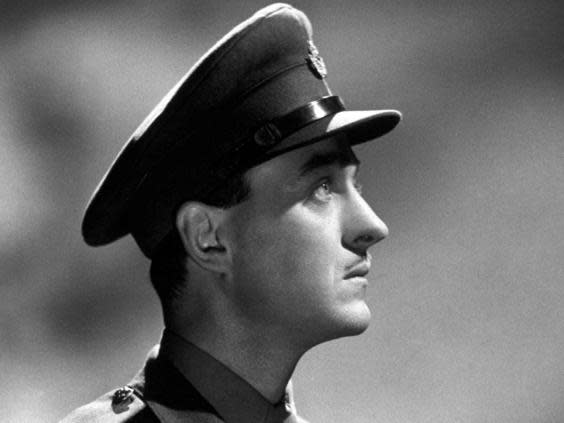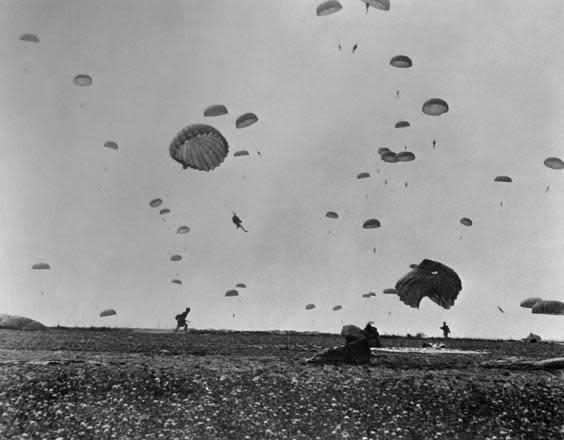D-Day at 75: The Scottish bagpiper, the Hollywood celebrities and the parachuting dogs who took part in the Normandy landings
The Allied invasion of Normandy beginning on 6 June 1944 was one of the pivotal events of the Second World War and is currently being commemorated across Europe on its 75th anniversary.
The assault on the beaches of northern France by British, American, Canadian and Free French troops on D-Day was the largest amphibious operation ever attempted and enabled the Western Allies crossing the English Channel from Portsmouth to gain an important foothold from which to commence its pushback against Nazi Germany.
The events of D-Day, codenamed Operation Neptune, are well documented and have been recreated in visceral detail in films like The Longest Day (1962) and Steven Spielberg’s Saving Private Ryan (1998) but some of the more unusual characters to have taken part do not always get their due.
The Scottish bagpiper
Among the most extraordinary sights (and sounds) on the beaches that day was “Piper Bill” Millin, a Canadian-born Scotsman who blew his bagpipes to rally the men storming the French sands.
[[gallery-0]]
Aged just 21, Millin was ordered to play by Simon Fraser, the 15th Lord Lovat, as shots rained down from the cliffs on Sword beach. He did so on the basis that English orders need not apply to Scots, playing “Highland Laddie”, “The Road to the Isles” and “All the Blue Bonnets are Over the Border” to stir the Allies to victory with the songs of home as they advanced to take Pegasus Bridge.
He did so wearing a kilt of Cameron tartan, the same worn by his father in Flanders during the First World War.
The celebrities
Several stars of the silver screen who had enlisted to serve their countries took part in D-Day.
Among the most famous were David Niven, the British actor best-remembered for A Matter of Life and Death (1946). Niven ended the war a lieutenant colonel and was one of the first British officers to land at Normandy. He had served with “Phantom”, a secret reconnaissance unit and would later be presented with the Legion of Merit by President Dwight D Eisenhower himself.
Sir Alec Guinness was also there, operating a British Royal Navy landing craft, while Henry Fonda served as a quartermaster on the destroyer the USS Satterlee. The great director John Ford was also at close quarters to shoot documentary footage of the operation.

Other Hollywood stars present include Richard Todd, Robert Montgomery, Charles Durning and James Doohan (later known as Scotty on Star Trek).
Todd, a captain, was part of the British airborne division who were parachuted in after the capture of Pegasus Bridge and would later play the man who led his battalion, Major John Howard, in The Longest Day, in which Fonda also featured.
The reclusive American novelist JD Salinger, author of The Catcher in the Rye (1951) was there, present at Utah Beach with the 12th Infantry Regiment, 4th Infantry Division, as were the civil rights activist Medgar Evers and the famed baseball pitcher Yogi Berra.
Theodore Roosevelt Jr, son of the 26th president of the US, won the Medal of Honour for his part in the day’s proceedings.
The paradogs
In the run up to D-Day, the 13th (Lancashire) Parachute Battalion had commenced a novel new experiment.
Tasked with readying canines for combat, they began to teach them to parachute too, meaning that specially trained dogs could be delivered to the beaches to assist with locating mines, warn against enemies and boost the morale of the men.
The project’s mastermind was Lance Corporal Ken Bailey, a vet in his civilian days but since posted on to the War Dog Training School in Hertfordshire.
The school had been housing dogs volunteered for the war effort since 1941, training them to remain calm when exposed to loud noises and identify the smell of explosives and gunpowder at the Larkhill Garrison.
In order to convince the dogs to jump using parachutes originally designed for bicycles, they had to be kept hungry and then enticed into making a leap of faith from an aircraft on the promise of scraps of meat.
The first to do so, according to Bailey’s notes, was a female Alsatian named Ranee. The dogs came to enjoy making the jump as they became more and more accustomed to their training.

On D-Day, the 13th Battalion’s three planes took to the skies each containing 20 men and a dog each: Ranee, another Alsatian named Monty and an Alsatian-Collie cross named Brian, nicknamed “Bing”.
Bing was overwhelmed by the chaos unfolding below him and initially refused to leap from the hatch, forcing an engineer to toss him out, only for his parachute to become ensnared in a tree from which he had to be rescued.
Monty would be wounded and Ranee lost, missing in action, but Bing’s courage won him the Dicken Medal, Britain’s highest honour for animals displaying “conspicuous gallantry or devotion to duty while serving with any branch of the Armed Forces or Civil Defence Units”.

 Yahoo News
Yahoo News 
